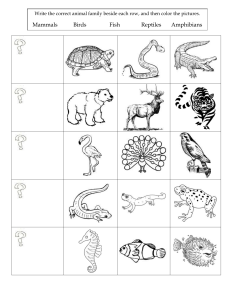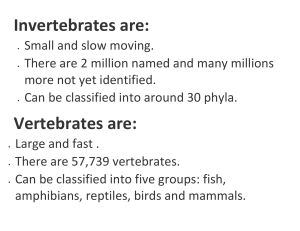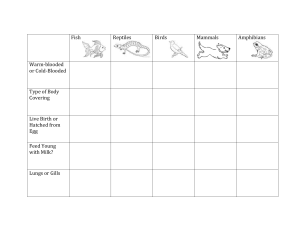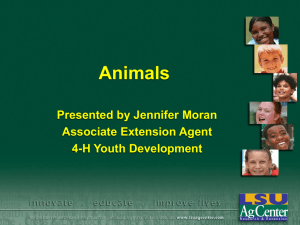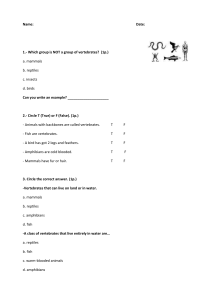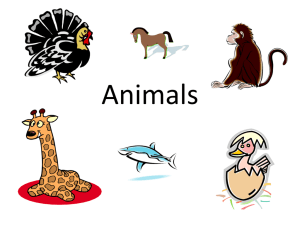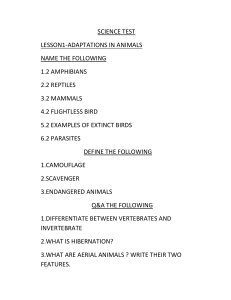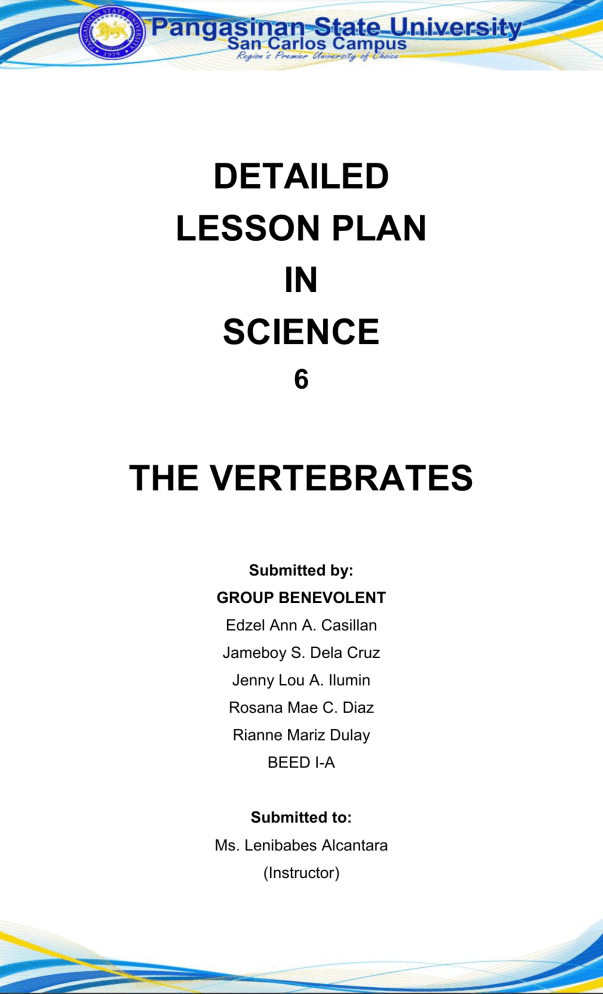
DETAILED LESSON PLAN IN SCIENCE 6 THE VERTEBRATES Submitted by: GROUP BENEVOLENT Edzel Ann A. Casillan Jameboy S. Dela Cruz Jenny Lou A. Ilumin Rosana Mae C. Diaz Rianne Mariz Dulay BEED I-A Submitted to: Ms. Lenibabes Alcantara (Instructor) I. OBJECTIVES At the end of the lesson, the pupils should be able to: A. Identify vertebrates according to their characteristics. B. Each group will create a short jingle about the five vertebrates. C. Appreciate the existence of these animals by sharing their ideas and opinions about the topic. II. SUBJECT MATTER Topic: The Vertebrates References: Science Textbook page 94 Materials: laptop, PowerPoint presentation III. LEARNING ACTIVITIES TEACHER’S ACTIVITY LEARNER’S ACTIVITY A. PRELIMINARY ACTIVITIES 1. Prayer Students, kindly stand. (name of a pupil), please lead the prayer. Are you ready to pray classmates? Yes, we are! Please bow your head and feel the presence of our Lord. 2. Greetings Good morning class. Before you take your seats, please pick up some piece of papers and arrange your chairs properly. Good morning, teacher. The students will pick the papers on the floor and arrange their chairs. You may now take your seats. Thank you, teacher. 3. Checking the Attendance Is there any absent from the class? Look at your right and smile if your seatmate is there. 4. Classroom Rules Giving of classroom rules (tacked on the board) The 5 P’s: Be Positive Be Productive Be Polite Be Prepared Be Respected Smiled to their seatmate and tell the teacher that there is no absent in the class. 5. Drill Identify whether the animal’s pictures shown in the flashcards are vertebrates or invertebrates. Clap once if it is invertebrates and clap twice if it is vertebrates. Butterfly Snake Grasshopper Bird Beetle Frog Bee Mosquito Spider Rat Clap once Clap twice Clap once Clap twice Clap once Clap twice Clap once Clap once Clap once Clap twice B. Review Before we proceed in our new topic for today, let us review our previous lesson from yesterday. Class, what was our topic yesterday? It is about nervous system, ma’am. Yes. Our topic was all about nervous system. What is nervous system? The nervous system is a network of cells and controls all the other parts of our body. Very good! What is the control center of nervous system? The brain, ma’am. You’re right! The brain is the control center of nervous system. And what is the control center of our body? That’s correct. Nervous system is the control center of the body. It directs the processes. It also receives information from the environment and makes specific body parts act on that information. Very good, class. You are really listening in our class. The control center of our body is the nervous system. Ma’am C. Motivation Now, let’s talk about our new topic. To give you some clue about our new lesson, I prepared a game that you can incorporate in our new lesson today. I will show you some words and you will have to guess what they are. Are you excited? Yes, ma’am. So, let's get started! HISF. Can you guess the word? Fish, ma’am Very good! IESLRPT. Next. What is this, class? Reptiles? Well tried! IRSBD. Can you guess this, class? That’s birds, ma’am Very good! MAHPSNAIB. How about this? Amphibians! That’s right! And the last one. LAMSAMM. What do you think is this, class? You’re right! Good job, class! Now, let’s proceed in our new lesson. D. Presentation of the Lesson The words that you guessed are vertebrate animals. That is the lesson we will be discussing today. Did you know that those animals are what we call vertebrate? Vertebrate are animals that have backbone. Their backbones support and protect their spinal cords and their bodies. Vertebrates are grouped according to their common characteristics. There are five classifications of vertebrates: mammals, birds, fish, reptiles, and amphibians. First, let’s talk about mammals. That’s mammals! Ma’am. What are these animals? A horse and a cat, ma’am. Very good! What are these animals body covering? They are covered with hair, ma’am. Yes, that’s right. These animals are covered with hair or fur for protection. How about these animals, class? Can you name these animals? A dog and a cow, ma’am All right. So, how were these animals born? They were born in forms that resemble their parents. How do the mother mammals feed their young or babies? Correct! Mother mammals feed their young by providing them with milk. What body part do they use to breathe air? Okay, they have lungs to breathe air. Class, always remember that… 1. Mammals are covered with hair or fur for protection. 2. They were born in forms that resemble their parents. 3. Mother mammals feed their young or babies by providing them with milk. 4. They have lungs to breathe air. Next is the bird. By providing them with milk, ma’am. Class, what are these animals? An eagle and a parrot, ma’am. Very good! We have an eagle and a parrot. What are these animals body covering? They are covered with feathers and have wings, ma’am. Yes, that’s right! Birds are covered with feathers and have wings which help them to fly. So, how do birds reproduce? They reproduce by laying eggs, ma’am. You are right! They reproduce by laying eggs. And how many feet do they have? They have two feet, ma’am. All right. Birds have two feet. Okay class, remember that … 1. Birds are covered with feathers and have wings which help them to fly. 2. They reproduce by laying eggs. 3. They have two feet. Let’s have the next one which is fish. Class, do you know these animals? All right. We have milk fish or bangus and galunggong. What are these animals body covering? They usually have scales on their body for its protection. Bangus and galunggong, ma’am. Where do fish live? They live in the water, ma’am. Yes, correct! They live in the water. How do fish reproduce? Okay, they reproduce by laying eggs. How do fish live in the water? Okay, they have tails for moving, fins for steering and maintaining balance and gills for breathing. Now class, always do remember that… 1. Fish usually have scales on their body for its protection 2. They live in the water. 3. They reproduced by laying eggs 4. They have tails for moving, fins for steering and maintaining balance and gills for breathing. And now, let’s talk about Reptiles. Class, what are these animals? Can you name them? A crocodile and a turtle, ma’am. Yes, correct! That is a crocodile and a turtle. What are these animals body covering? They are covered with dry skin and hard scales. Where do reptiles live? They live in water and on land although they are more adaptable to live on land for extended periods of time because they have developed lungs and body structures. How do they reproduce? You’ve got it right! Reptiles reproduce by laying eggs. Class, always do remember that… They reproduce by laying eggs. 1. Reptiles are covered with dry skin and hard scales. 2. They live in the water and on land although they are more adaptable to live on land for extended periods of time because they have developed lungs and body structures. 3. They reproduce by laying eggs. And lastly, we have amphibians. Class, do you know these animals? Can you name them? A frog and a salamander, ma’am. Very good! Those are frogs and a salamander. What are these animals body covering? Okay, they have moist and smooth skin on their bodies. Where do amphibians live? That’s right! They can live both in water and on land. Amphibians live in water when they are still young, thus they have gills to breathe. As they grow older, they live on land, their gills disappear and developed their lungs. How do amphibians reproduce? Okay, they lay soft eggs without shells in water. Class, always do remember that… 1. Amphibians have moist and smooth skin on their bodies. 2. They can live both in water and on land. They live in water when they are still young, thus they have gills to breathe. As they grow older, they live on land, their gills disappear and developed their lungs. 3. They lay soft eggs without shells in water. They can live both in water and on land. Okay, class. Do you still remember the five (5) classifications of vertebrates? Can you enumerate them? The five groups of vertebrates are the mammals, birds, fish, reptiles, and amphibians. That’s correct! We have the mammals, birds, fish, reptiles, and amphibians. Very good, class. You're paying attention in our class. E. Generalization Okay, class, we are done with discussing the vertebrates and the five classifications. Now let us recall what we discussed today. Okay, what are vertebrates and what Vertebrates are animals that are the different groups of vertebrates? have a backbone and divided into 5 groups; namely mammals, birds, reptiles, amphibians, and fish. Good job! Animals that have a backbone are called vertebrates. Vertebrates are classified into five groups, namely: mammals, birds, reptiles, amphibians, and fish. Class, what are the characteristics of mammals? Mammals have hair and they produce milk for their young. Very good! Mammals have hair. They produce milk. They have lungs. And lastly, they were born in forms that resembled their parents. What are the characteristics of fish? Fish live in water and have scales, tails, fins, and gills. Correct! Fish usually have scales, tails for moving, fins for steering and maintaining balance, and gills to breathe. They live in the water. And lastly, they lay eggs. What are the characteristics of amphibians? Good job, class! Amphibians can live on water and land, and they have wet bodies. Amphibians have moist and smooth skin. They can live both in water and on land. And lastly, they lay soft eggs without shells in the water. And what are the characteristics of reptiles? Reptiles can live on land and water. They have dry skin and a hard shell, and they lay eggs. Yes, correct! Reptiles are covered with dry skin and hard scales. They live on land and water. And lastly, they lay eggs. And lastly, what are the characteristics of birds? Very good! Birds have feathers and wings. They lay eggs, and most birds can fly, while some others cannot. Birds are covered with feathers and wings. They lay eggs. And lastly, they have two feet. Do we need to take care of animals? Why or why not? We need to take care of animals because they are part of the ecosystem. They balance the natural resources and they help us as well. Very well said. Yes, we need to care animals because they play an important role in balancing nature. They help plants spread seeds. They help humans in day-to-day work. What do you think is the right thing to do in showing your care for them? Excellent answer! We can give them a life that corresponds to their natural tendencies We can provide them with their proper needs, especially food that they naturally eat and a habitat where they can breed. F. Application Since we have finished identifying what vertebrates are and their classifications. Divide the class into five (5) groups. Make a name for your groups that is related to our topic. Each group will create a short jingle about the five vertebrates. By knowing their basic characteristics, we can provide them with a life that fits their natural living. The students will be judge using the rubric given below. IV. EVALUATION A. Choose the animal that DOES NOT belong to the group. 1. fish 2. tadpole 3. hawk 4. toad 5. salmon mammals salamander eagle gecko lamprey reptiles frog ostrich snake tilapia insects turtle crow cat milkfish B. Identify the vertebrate that is being described by the statement. Select the letter of your choice. F- Fish A- Amphibian R- Reptile B- Bird M- Mammal 1. Its body is covered with moist and slimy skin. They can live both in water and on land. 2. They have tails for moving, fins for steering and maintaining balance and gills for breathing. 3. Its body is covered with dry skin and scales. 4.. It nourishes its young with milk from the mammary glands. 5. These animals are covered with hair or fur for protection. V. ASSIGNMENT Direction: Compare and contrast the following vertebrates. 1. shark and dolphin 2. duck and duck-billed platypus 3. eagle and ostrich 4. frog and toad 5. dog and kangaroo
